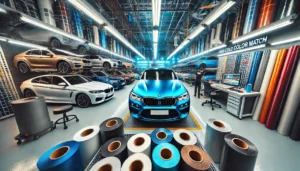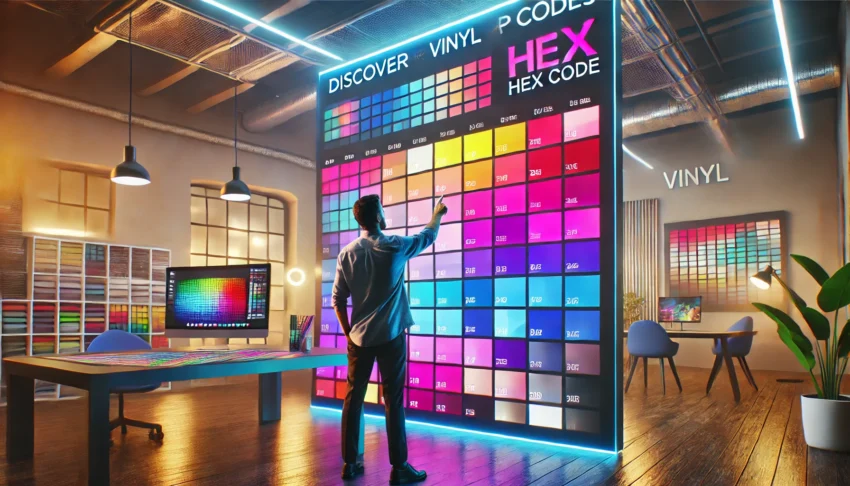Vinyl wrap has become an increasingly popular choice for customizing vehicles, providing a sleek and modern look without the permanent commitment of paint. But if you want to find the exact hex code of a vinyl wrap, either for color matching or designing, the process requires a bit of precision. In this guide, we’ll walk through how to find the hex code of a vinyl wrap, how to choose the right wrap color, and how to match vinyl wrap colors with paint codes.
Can You Get Vinyl Wrap in Paint Code?
Yes, many vinyl wrap manufacturers offer wraps that match specific OEM paint codes. This allows vehicle owners to get a precise color match between their car’s original paint and the vinyl wrap. Popular brands like 3M and Avery Dennison offer a wide range of vinyl wraps that can match traditional paint colors, making it easier for you to achieve a seamless look.
How Do You Calculate Vinyl Wrap?
To calculate the amount of vinyl wrap you need, consider the surface area of the vehicle or object you’re wrapping. For a vehicle, measure the length, width, and height to calculate the total area, then add extra material to account for curves, edges, and mistakes.
Here’s a simple formula:
- Total Surface Area = Length x Width
- Add an additional 10-15% for overage.
For example, if the surface area is 200 square feet, you’ll want to order at least 220 square feet of vinyl wrap to cover the entire vehicle.
How Do I Choose a Wrap Color?
Choosing the right vinyl wrap color depends on the look you’re trying to achieve. Here are a few considerations:
- Match with Existing Colors: If you’re looking for a specific color to match your vehicle, you may want to use the OEM paint code as a reference when selecting your wrap.
- Use Online Visualizers: Many vinyl wrap brands offer online visualizers where you can see how different colors would look on your vehicle.
- Consider the Finish: Gloss, matte, satin, and metallic finishes each give a different aesthetic. Choose based on whether you want a sleek, shiny finish or a more understated look.
How Do You Set Vinyl Wrap?
Setting a vinyl wrap properly is essential for achieving a smooth, bubble-free application. Here’s a basic step-by-step guide:
- Prepare the Surface: Make sure the surface is thoroughly cleaned to eliminate any dirt, grease, or wax.
- Measure and Cut the Vinyl: Cut the vinyl to the size of the panel you’re wrapping, leaving some extra material for adjustments.
- Apply the Wrap: Start at one end and gradually apply the wrap, using a squeegee to smooth out air bubbles as you go.
- Heat the Vinyl: Use a heat gun to soften the vinyl, which helps it stretch and fit snugly around curves and edges.
- Trim Excess Vinyl: Carefully trim away any excess material for a clean finish.
What is Vinyl Wrap Made Of?
Vinyl wrap is typically made of a polyvinyl chloride (PVC) film. It’s flexible, durable, and designed to conform to various surfaces, making it perfect for vehicle applications. The vinyl is often combined with a pressure-sensitive adhesive to allow easy application and repositioning during installation.
What is the Heat Setting for Vinyl Wrap?
When applying vinyl wrap, using the correct heat setting is important. The ideal temperature for applying vinyl wrap is between 180°F and 220°F (82°C – 104°C). This ensures the vinyl is pliable enough to conform to curves but won’t overheat or stretch excessively, which could damage the material.
How Do You Do a Wrap Set?
To complete a wrap set, follow these steps:
- Focus on Flat Areas First: Begin by applying the wrap to large, flat sections like the hood or doors for smoother coverage.
- Move to Curves and Edges: Use a heat gun to soften the vinyl and apply it to curved areas, making sure to press out any bubbles.
- Finish with Details: Carefully wrap around mirrors, door handles, and other small details using precision tools.
How Do You Preserve Vinyl Wrap?
To preserve your vinyl wrap and keep it looking new for longer, follow these tips:
- Regular Cleaning: Clean the wrap with water and mild soap.
- Avoid Harsh Materials: Stay clear of using abrasive materials that could damage the wrap’s surface.
- Protect from Harsh Weather: Park the vehicle in shaded spots to reduce exposure to direct sunlight, which can lead to fading.
- Use Wrap-Safe Products: Avoid using harsh chemicals or waxes that are not designed for vinyl wraps.
How Do You Set Up a Wrap?
Installing a vinyl wrap requires both careful preparation and attention to detail. First, ensure the vehicle’s surface is properly cleaned. Measure the surface areas and cut the vinyl wrap accordingly. Apply the vinyl gradually, using heat to contour the material around edges and curves.
How Do You Make Vinyl Wrap Last Longer?
To make your vinyl wrap last longer, take care of it by following these maintenance practices:
- Hand Wash Regularly: Avoid automatic car washes that use harsh brushes, as they can damage the wrap.
- Apply a Vinyl-Safe Coating: Use protective coatings designed for vinyl wraps to prevent fading and scratches.
- Avoid Prolonged Sun Exposure: Excessive exposure to UV rays can cause the vinyl to fade, so park in shaded areas when possible.
How to Find the Hex Code of Vinyl Wrap for Different Brands
Finding the hex code of a vinyl wrap can help you achieve precise color matching for custom designs. Many manufacturers provide hex codes for their vinyl wraps, making it easier to match specific colors across different platforms.
Here’s how to find the hex code for vinyl wrap:
- Check the Manufacturer’s Website: Some vinyl wrap brands, like 3M or Avery Dennison, offer detailed color charts that include the hex codes.
- Use a Color Matching Tool: Take a photo of the vinyl wrap and upload it to an online color-matching tool. These tools can analyze the image and provide the matching hex code for the vinyl wrap color.
- Use a Colorimeter: For precise color matching, a colorimeter can be used to scan the vinyl wrap and provide the exact hex code.
Hex Code Accuracy
Using a Colorimeter for Precise Hex Code Matching
While using a colorimeter can provide the most accurate hex code for a vinyl wrap, it’s essential to follow proper procedures and consider potential factors that can affect the reading.
Calibration:
- Regular calibration: Ensure your colorimeter is calibrated regularly according to the manufacturer’s instructions. Calibration ensures accurate readings and consistent results.
- Calibration standards: Use industry-standard calibration plates or tiles to calibrate your colorimeter.
Environmental Factors:
- Lighting conditions: Avoid direct sunlight or artificial lighting that can affect the color reading. Conduct measurements in a well-lit, shaded area.
- Temperature and humidity: Extreme temperature fluctuations or high humidity can impact the accuracy of the colorimeter. Maintain a stable environment for measurements.
Surface Preparation:
- Clean surface: Ensure the vinyl wrap surface is clean and free of dirt, grease, or contaminants. These substances can interfere with the colorimeter’s reading.
- Even pressure: Apply even pressure to the colorimeter’s sensor when measuring the vinyl wrap. Inconsistent pressure can lead to inaccurate readings.
Colorimeter Settings:
- Appropriate settings: Use the colorimeter settings recommended by the manufacturer for vinyl wrap measurements. Incorrect settings can result in inaccurate readings.
By following these guidelines, you can maximize the accuracy of your hex code measurements using a colorimeter.
Vinyl Wrap Durability
Factors Affecting Vinyl Wrap Durability
While vinyl wrap is generally durable, several factors can influence its lifespan:
UV Exposure:
- Prolonged exposure: Excessive exposure to ultraviolet (UV) rays from sunlight can cause the vinyl wrap to fade, discolor, or become brittle.
- Protective coatings: Consider applying a UV-resistant protective coating to help shield the vinyl wrap from harmful UV rays.
Temperature Extremes:
- Heat and cold: Extreme temperatures, both hot and cold, can affect the vinyl wrap’s flexibility and durability. Sudden temperature changes can cause the vinyl to crack or peel.
- Garaging: When possible, garage your vehicle to protect it from extreme temperature fluctuations.
Chemical Exposure:
- Harsh substances: Avoid exposing the vinyl wrap to harsh chemicals, such as solvents, degreasers, or gasoline. These substances can damage the vinyl’s surface and reduce its lifespan.
- Cleaning products: Use mild, vinyl-safe cleaning products to clean the vinyl wrap.
Improper Installation:
- Poor adhesion: If the vinyl wrap is not properly installed or adhered to the surface, it may peel or lift, reducing its durability.
- Professional installation: Consider having a professional installer apply the vinyl wrap to ensure proper adhesion and long-lasting results.
Maintenance:
- Regular cleaning: Gently clean the vinyl wrap with a mild soap and water solution to remove dirt and grime.
- Avoid abrasive materials: Don’t use abrasive materials, such as brushes or scouring pads, that can scratch the vinyl wrap’s surface.
By considering these factors and taking appropriate precautions, you can help prolong the life of your vinyl wrap.
DIY vs. Professional Installation
Choosing Between DIY and Professional Vinyl Wrap Installation
Deciding whether to install vinyl wrap yourself or hire a professional depends on several factors:
Skill Level:
- Experience: If you have experience working with automotive materials and have a good eye for detail, you may be able to successfully install vinyl wrap yourself.
- Complexity: If the vehicle has complex curves, edges, or intricate details, professional installation may be more suitable.
Time and Resources:
- Availability: Installing vinyl wrap can be time-consuming. Ensure you have the time and patience to complete the project.
- Tools and materials: You’ll need specific tools and materials for vinyl wrap installation. Consider the cost and availability of these resources.
Desired Outcome:
- Quality: Professional installers have the experience and expertise to achieve a high-quality finish, ensuring the vinyl wrap looks seamless and lasts longer.
- Warranty: Some professional installers offer warranties on their work, providing additional peace of mind.
OEM Color Match Vinyl Wrap

OEM color match vinyl wrap is designed to replicate the original factory paint colors of vehicles. This is a great option if you’re looking to change the look of your car without straying too far from the original paint. Manufacturers like 3M offer vinyl wraps in a wide range of OEM paint colors.
3M Vinyl Wrap Color Match
3M offers a wide selection of vinyl wraps that match many OEM paint codes. If you’re looking for a specific color, you can search through 3M’s color catalog or visit a 3M distributor to find the right match. Many of their vinyl wraps come with corresponding hex codes, making it easier to incorporate the colors into digital designs.
Finding Vinyl Wrap Color Matches Near You
If you’re searching for vinyl wrap color matches near you, many authorized retailers or installers have samples available. Visit local vinyl wrap shops to view swatches and find the best color match for your project. You can also request samples online from major brands like 3M, Avery Dennison, and Orafol.
Conclusion
Finding the right hex code for vinyl wrap can help ensure a seamless design and color match, whether you’re customizing a vehicle or using the wrap in a digital project. By using manufacturer resources, color-matching tools, and visiting local vinyl wrap shops, you can find the perfect vinyl wrap color for your needs.
FAQs
How do I find the hex code for vinyl wrap?
Check the manufacturer’s website, use an online color-matching tool, or use a colorimeter to determine the hex code of your vinyl wrap.
Can vinyl wrap match my vehicle’s paint code?
Yes, many vinyl wrap brands offer wraps that match OEM paint codes, making it easy to replicate your vehicle’s original color.
How long does vinyl wrap last?
With proper care and maintenance, vinyl wrap can last anywhere from 5 to 7 years.
How do I make vinyl wrap last longer?
To extend the life of your vinyl wrap, clean it regularly, avoid abrasive materials, and use vinyl-safe protective coatings.
Can I apply vinyl wrap myself?
Yes, with the right tools and preparation, you can apply vinyl wrap on your own. However, professional installation ensures a smoother, longer-lasting finish.

